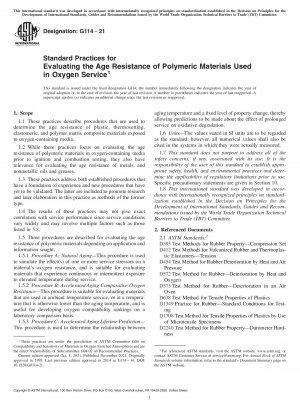ASTM G114-21
Standard Practices for Evaluating the Age Resistance of Polymeric Materials Used in Oxygen Service
- Standard No.
- ASTM G114-21
- Release Date
- 2021
- Published By
- American Society for Testing and Materials (ASTM)
- Latest
- ASTM G114-21
- Scope
- 1.1 These practices describe procedures that are used to determine the age resistance of plastic, thermosetting, elastomeric, and polymer matrix composite materials exposed to oxygen-containing media. 1.2 While these practices focus on evaluating the age resistance of polymeric materials in oxygen-containing media prior to ignition and combustion testing, they also have relevance for evaluating the age resistance of metals, and nonmetallic oils and greases. 1.3 These practices address both established procedures that have a foundation of experience and new procedures that have yet to be validated. The latter are included to promote research and later elaboration in this practice as methods of the former type. 1.4 The results of these practices may not give exact correlation with service performance since service conditions vary widely and may involve multiple factors such as those listed in 5.8. 1.5 Three procedures are described for evaluating the age resistance of polymeric materials depending on application and information sought. 1.5.1 Procedure A: Natural Aging—This procedure is used to simulate the effect(s) of one or more service stressors on a material’s oxygen resistance, and is suitable for evaluating materials that experience continuous or intermittent exposure to elevated temperature during service. 1.5.2 Procedure B: Accelerated Aging Comparative Oxygen Resistance—This procedure is suitable for evaluating materials that are used in ambient temperature service, or at a temperature that is otherwise lower than the aging temperature, and is useful for developing oxygen compatibility rankings on a laboratory comparison basis. 1.5.3 Procedure C: Accelerated Aging Lifetime Prediction— This procedure is used to determine the relationship between aging temperature and a fixed level of property change, thereby allowing predictions to be made about the effect of prolonged service on oxidative degradation. 1.6 Units—The values stated in SI units are to be regarded as the standard; however, all numerical values shall also be cited in the systems in which they were actually measured. 1.7 This standard does not purport to address all of the safety concerns, if any, associated with its use. It is the responsibility of the user of this standard to establish appropriate safety, health, and environmental practices and determine the applicability of regulatory limitations prior to use. Specific precautionary statements are given in Section 10. 1.8 This international standard was developed in accordance with internationally recognized principles on standardization established in the Decision on Principles for the Development of International Standards, Guides and Recommendations issued by the World Trade Organization Technical Barriers to Trade (TBT) Committee.
ASTM G114-21 Referenced Document
- ASTM D1349 Standard Practice for Rubber-Standard Temperatures for Testing
- ASTM D1708 Standard Test Method for Tensile Properties of Plastics By Use of Microtensile Specimens
- ASTM D2240 Standard Test Method for Properties of Rubber &8212; Durometer Hardness*, 2024-04-21 Update
- ASTM D2512 Standard Test Method for Compatibility of Materials with Liquid Oxygen (Impact Sensitivity Threshold and Pass-Fail Techniques)
- ASTM D2863 Standard Test Method for Measuring the Minimum Oxygen Concentration to Support Candle-like Combustion of Plastics (Oxygen Index)
- ASTM D3039/D3039M Standard Test Method for Tensile Properties of Polymer Matrix Composite Materials
- ASTM D3045 Standard Practice for Heat Aging of Plastics Without Load
- ASTM D395 Standard Test Methods for Rubber Property-Compression Set
- ASTM D412 Standard Test Methods for Vulcanized Rubber and Thermoplastic Elastomers8212;Tension
- ASTM D454 Standard Test Method for Rubber Deterioration by Heat and Air Pressure
- ASTM D4809 Standard Test Method for Heat of Combustion of Liquid Hydrocarbon Fuels by Bomb Calorimeter (Precision Method)
- ASTM D572 Standard Test Method for Rubber-Deterioration by Heat and Oxygen
- ASTM D573 Standard Test Method for Rubber-Deterioration in an Air Oven
- ASTM D638 Standard Test Method for Tensile Properties of Plastics
- ASTM G125 Standard Test Method for Measuring Liquid and Solid Material Fire Limits in Gaseous Oxidants
- ASTM G126 Standard Terminology Relating to the Compatibility and Sensitivity of Materials in Oxygen Enriched Atmospheres
- ASTM G63 Standard Guide for Evaluating Nonmetallic Materials for Oxygen Service
- ASTM G72 Standard Test Method for Autogenous Ignition Temperature of Liquids and Solids in a High-Pressure Oxygen-Enriched Environment
- ASTM G74 Standard Test Method for Ignition Sensitivity of Materials to Gaseous Fluid Impact
- ASTM G86 Standard Test Method for Determining Ignition Sensitivity of Materials to Mechanical Impact in Ambient Liquid Oxygen and Pressurized Liquid and Gaseous Oxygen Environments
- ASTM G94 Standard Guide for Evaluating Metals for Oxygen Service
- ISO 2578 Plastics; determination of time-temperature limits after prolonged exposure to heat
- ISO 9080 Plastics piping and ducting systems - Determination of the long-term hydrostatic strength of thermoplastics materials in pipe form by extrapolation
ASTM G114-21 history
- 2021 ASTM G114-21 Standard Practices for Evaluating the Age Resistance of Polymeric Materials Used in Oxygen Service
- 2014 ASTM G114-14 Standard Practices for Evaluating the Age Resistance of Polymeric Materials Used in Oxygen Service
- 2007 ASTM G114-07 Standard Practices for Evaluating the Age Resistance of Polymeric Materials Used in Oxygen Service
- 2006 ASTM G114-06 Standard Practices for Evaluating the Age Resistance of Polymeric Materials Used in Oxygen Service
- 1998 ASTM G114-98 Standard Practice for Aging Oxygen-Service Materials Prior to Ignitibility or Flammability Testing
